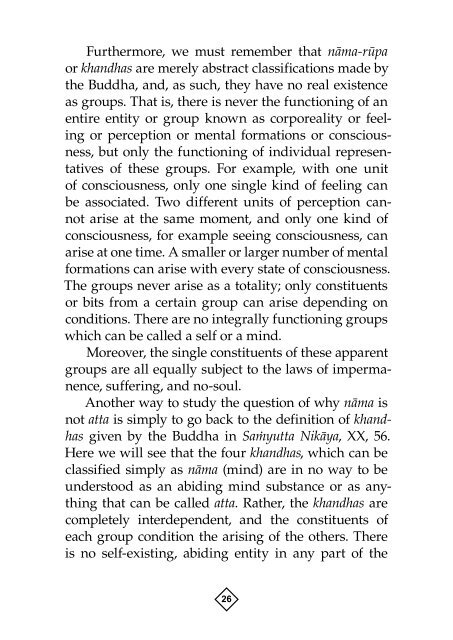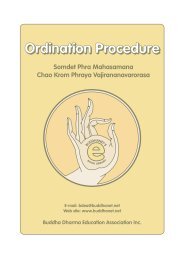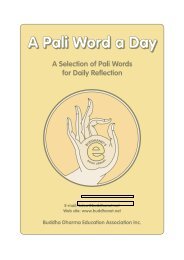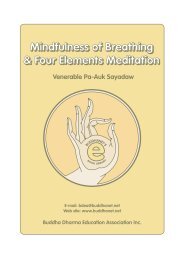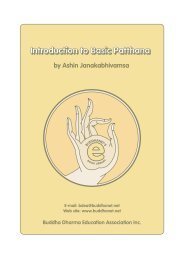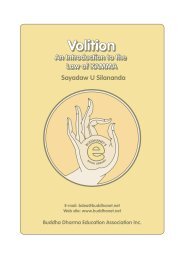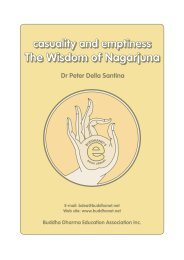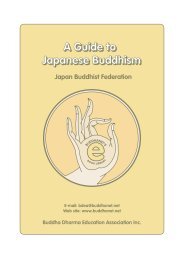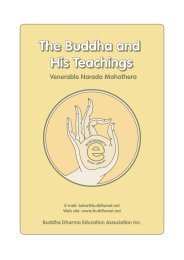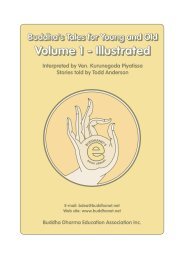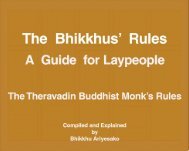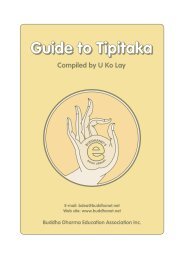No Inner Core: An Introduction to the Doctrine of Anatta - BuddhaNet
No Inner Core: An Introduction to the Doctrine of Anatta - BuddhaNet
No Inner Core: An Introduction to the Doctrine of Anatta - BuddhaNet
Create successful ePaper yourself
Turn your PDF publications into a flip-book with our unique Google optimized e-Paper software.
Fur<strong>the</strong>rmore, we must remember that nàma-råpa<br />
or khandhas are merely abstract classifications made by<br />
<strong>the</strong> Buddha, and, as such, <strong>the</strong>y have no real existence<br />
as groups. That is, <strong>the</strong>re is never <strong>the</strong> functioning <strong>of</strong> an<br />
entire entity or group known as corporeality or feeling<br />
or perception or mental formations or consciousness,<br />
but only <strong>the</strong> functioning <strong>of</strong> individual representatives<br />
<strong>of</strong> <strong>the</strong>se groups. For example, with one unit<br />
<strong>of</strong> consciousness, only one single kind <strong>of</strong> feeling can<br />
be associated. Two different units <strong>of</strong> perception cannot<br />
arise at <strong>the</strong> same moment, and only one kind <strong>of</strong><br />
consciousness, for example seeing consciousness, can<br />
arise at one time. A smaller or larger number <strong>of</strong> mental<br />
formations can arise with every state <strong>of</strong> consciousness.<br />
The groups never arise as a <strong>to</strong>tality; only constituents<br />
or bits from a certain group can arise depending on<br />
conditions. There are no integrally functioning groups<br />
which can be called a self or a mind.<br />
Moreover, <strong>the</strong> single constituents <strong>of</strong> <strong>the</strong>se apparent<br />
groups are all equally subject <strong>to</strong> <strong>the</strong> laws <strong>of</strong> impermanence,<br />
suffering, and no-soul.<br />
<strong>An</strong>o<strong>the</strong>r way <strong>to</strong> study <strong>the</strong> question <strong>of</strong> why nàma is<br />
not atta is simply <strong>to</strong> go back <strong>to</strong> <strong>the</strong> definition <strong>of</strong> khandhas<br />
given by <strong>the</strong> Buddha in Saÿyutta Nikàya, XX, 56.<br />
Here we will see that <strong>the</strong> four khandhas, which can be<br />
classified simply as nàma (mind) are in no way <strong>to</strong> be<br />
unders<strong>to</strong>od as an abiding mind substance or as anything<br />
that can be called atta. Ra<strong>the</strong>r, <strong>the</strong> khandhas are<br />
completely interdependent, and <strong>the</strong> constituents <strong>of</strong><br />
each group condition <strong>the</strong> arising <strong>of</strong> <strong>the</strong> o<strong>the</strong>rs. There<br />
is no self-existing, abiding entity in any part <strong>of</strong> <strong>the</strong><br />
26


